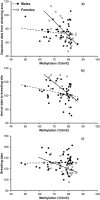Migration phenology and breeding success are predicted by methylation of a photoperiodic gene in the barn swallow
- PMID: 28361883
- PMCID: PMC5374444
- DOI: 10.1038/srep45412
Migration phenology and breeding success are predicted by methylation of a photoperiodic gene in the barn swallow
Abstract
Individuals often considerably differ in the timing of their life-cycle events, with major consequences for individual fitness, and, ultimately, for population dynamics. Phenological variation can arise from genetic effects but also from epigenetic modifications in DNA expression and translation. Here, we tested if CpG methylation at the poly-Q and 5'-UTR loci of the photoperiodic Clock gene predicted migration and breeding phenology of long-distance migratory barn swallows (Hirundo rustica) that were tracked year-round using light-level geolocators. Increasing methylation at Clock poly-Q was associated with earlier spring departure from the African wintering area, arrival date at the European breeding site, and breeding date. Higher methylation levels also predicted increased breeding success. Thus, we showed for the first time in any species that CpG methylation at a candidate gene may affect phenology and breeding performance. Methylation at Clock may be a candidate mechanism mediating phenological responses of migratory birds to ongoing climate change.
Conflict of interest statement
The authors declare no competing financial interests.
Figures



References
-
- Nussey D. H., Wilson A. J. & Brommer J. E. The evolutionary ecology of individual phenotypic plasticity in wild populations. J. Evol. Biol. 20, 831–844 (2007). - PubMed
-
- Both C., van Asch M., Bijlsma R. G., van den Burg A. B. & Visser M. E. Climate change and unequal phenological changes across four trophic levels: constraints or adaptations. J. Anim. Ecol. 78, 73–83 (2009). - PubMed
-
- Verhulst E. C. et al.. Evidence from pyrosequencing indicates that natural variation in animal personality is associated with DRD4 DNA methylation. Mol. Ecol. 25, 1801–1811 (2016). - PubMed
Publication types
MeSH terms
Substances
LinkOut - more resources
Full Text Sources
Other Literature Sources

